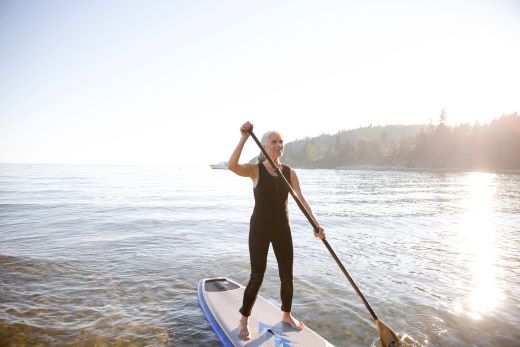If you've been dreaming of windsurfing, welcome aboard! It's no wonder the sport's grown so popular. It's challenging yet exhilarating and safe for most ages to try (with adult supervision).
The feeling of freedom as you pick up speed, the perfect glide under your feet, the workout you get, and the mental challenge of mastering balance – are all part of why it's one of our favorite water sports. And today, we'll share our top windsurfing tips to get you on that board and flying across the water!
What is Windsurfing?
Inspired by Newman Darby in 1948 and further developed by aeronautical engineer Jim Drake and surfer Hoyle Schweitzer around the 1960s, windsurfing is an action-packed sport combining surfing and sailing. It's perfect for those seeking an adrenaline rush on the water.
Windsurfing Tips For Perfecting Your Ride
Learning how to windsurf can be tricky at first, so prepare with a few pieces of advice from our water sports experts:
1. Get to Know the Equipment
Before we dive into our best windsurfing tips, let's break down the essential equipment:
- The sail: This catches the wind's energy, propelling you forward or backward.
- The mast: It's the thin, vertical pole that acts as the backbone, supporting the sail.
- The boom: This horizontal bar connects to the mast and helps the sail hold its shape.
- The board: This surfboard-like platform is where you balance and catch the wind with the sail.
- The fin: Mounted on the underside of the board at the back, the fin provides stability and control, essential for maneuvering, jumping, and planing.
Now, the fun part! All these parts work together by steering with your feet and adjusting the sail to control your speed.
2. Practice How to Windsurf on Land
First, practice the basics on dry land before going into the water. You can get comfortable standing on the board, maneuvering the gear, steering, and more. It's the same idea surfers use when they practice on land first.
Imagine: you're out on the water, waves or no waves, trying to balance on your board while wrestling with all this new equipment flopping around. Yikes! By practicing on land first, you'll be much smoother sailing (pun intended) when you hit the waves.
3. Find a Flat Location
When first starting out, it's easiest to sail with the wind blowing alongside the shore. This makes it much easier to sail back and forth – compared to sailing directly into the wind.
Learn More About Sailing in Different Wind Conditions
4. Wait for the Perfect Weather
Before venturing out on a first try, waiting for calm seas and winds of 12–15 knots is best. Additionally, you should avoid extreme weather conditions, including rain, high winds, and very frigid temperatures. (The cold water tires your body out quicker.)
5. Don’t Be Afraid When Learning How to Windsurf
Windsurfing takes a bit to get the hang of, but it is more straightforward than you might think. Here's how to get started:
- Find deep enough water and lay your board flat, sail facing downwind.
- Kneel on the board, grab the uphaul line (controls the sail), and when you feel steady, slowly stand up.
- Raise the sail with the uphaul, keeping your back straight and holding the mast with both hands.
Now comes steering:
- Tilt the mast and your body together. Lean one way to turn in that direction. The more you tilt and the stronger the wind, the sharper your turn.
Ready to move?
- Grab the boom near the mast, lean back to keep the sail upright, and use your backhand for speed control – pull to go faster, release to slow down.
6. Take Lessons from a Pro
Learning how to windsurf has a learning curve, but you'll overcome those hurdles much faster with instructor support. Essentially, lessons equip you with the fundamentals and help you navigate the common difficulties beginners face.
A pro will provide windsurfing tips for everything: standing up, maneuvering the sail for direction control, and even carrying your board to the water without a runaway incident. They'll also explain windsurfing safety fundamentals in detail, which we'll cover briefly next.
7. Remember Basic Windsurfing Safety Guidelines
For a smooth ride and to wrap up our tips, let's review some key windsurfing safety points to keep in mind while learning:
- Never go windsurfing alone or at night.
- Gear up with safety essentials like a life jacket and helmet.
- Stay aware of your surroundings – watch out for other surfers, boats, and swimmers, and remember who has the right of way.
- Dress for the conditions: wear a wetsuit in cold water and sun protection for long days under the sun.
- Stay hydrated and avoid getting too tired.
Conquer the Waves: Essential Windsurfing Safety Tips for Beginners
Now that you're armed with some windsurfing basics, it's time to hit the water! Find an instructor or a friend to join you, and give it a go. And for more water sports wisdom, be sure to explore our boating blog.


